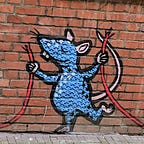Viaje a Espagña — Segovia
Segovia is another small, medieval mountaintop city some forty miles from Madrid, but to the north, on the other side of the Guadarrama range, which is still snow-capped in May. Segovia has three must-sees: the cathedral, the Alcazar (Islamic fortress), and the Roman aqueduct.
The aqueduct reminded me of a line in Neil Young’s Cortez the Killer: “They built up with their bare hands what we still can’t do today.” Without mortar, the Romans constructed a nine-mile aqueduct, much of it underground, to channel water to an outpost overlooking the Spanish plain. Nearly half a mile of the above-ground structure remains. It was damaged during the Reconquista (the centuries-long crusade to push the Moors out of Iberia) and rebuilt in some spots; you can see where the Spaniards used mortar because they couldn’t do what the Romans did.
At Segovia’s Plaza Mayor we bought a piece of ponche segoviano, the local dessert of choice, and each had half. Spanish cuisine features two spices: way too much sugar and way too much salt. Guess which one this had? If we’d split our ponche segoviano into twentieths and shared it with the old people on the benches in the square, we’d have killed two of them from sudden-onset diabetes and sent the rest into sugar shock. Between the sugar, salt, and smoking, The Fabulous Wife believes most Spaniards die by seventy from diabetes, hypertension, cancer, or some combination thereof.
The cathedral, just off the Plaza Mayor, was begun during the Gothic era (1525) but finished during the heyday of Renaissance architecture (1768) so it’s a mixture of both, the biggest giveaway being that it started with spires but is crowned by a dome.
It’s not as over-the-top as Toledo’s cathedral. The organ is merely elaborate.
Nonetheless, it’s another example of designers and artisans from a much earlier time doing with their bare hands what we, with our computers and precision tools, cannot do today. Or maybe do not want to do, either because we fail to recognize what art does for us or because we consider “ornamentation” a frivolous expense.
The Alcazar is built on the site of the Roman fortress that got its water from the aqueduct. After the Christians seized Segovia, the Alcazar became a palace for Castilian royalty. More recently it served as an artillery school for the Spanish military. It was largely rebuilt after a fire in 1862, so it isn’t really an authentic castle, but it is impressive.
Despite the Spanish Christians’ attempt to whitewash Iberia’s Islamic past, the legacy stubbornly pokes through here and there.
Yet for all its splendor, the Alcazar existed for a grim reason: if an attacking force were coming, you’d know it three days in advance, as the flat plain affords an expansive view in every direction except south, where the mountain range provides protection. No wonder Segovia was never taken in a siege.
Segovia was the quietest, least-touristed Spanish city we visited. For that reason alone it would have been fun, but all three must-sees — especially the aqueduct — lived up to the hype.
